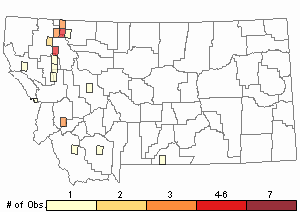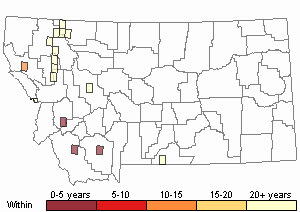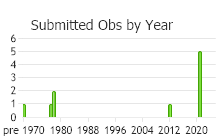View in other NatureServe Network Field Guides
NatureServe
Montana
Utah
Wyoming
Idaho
Wisconsin
British Columbia
South Carolina
Yukon
California
New York
Lyall's Polytrichum Moss - Meiotrichum lyallii
Other Names:
Polytrichum lyallii, Polytrichadelphus lyallii, Polytrichastrum lyallii
General Description
Plant: Robust, erect moss growing in loose tufts or among other mosses. Dark green, but becoming red-brown with age. Stems 2-3(7) cm tall, simple or at base sparingly branched. Leafier in upper portion of stem.
Leaf: When dry, leaves are very imbricate, somewhat spreading, and sub-tubular. When moist, leaves are plane or recurved, and not reflexed at hinge. Leaf is lanceolate shaped, 4-10 mm long, and has a sheathing base (1.5-2.0 mm long). Leaf is serrately toothed and firm. Sheath has a margin that is entire, hyaline, and has a narrow margin of elongated hinge-cells in the tapering portion. Costa is slightly excurrent as a short spine (weak) or is smooth, and is made of lamellae.
Leaf Cells: Each tooth consists of 1-2 small cells at the base topped by 1 large cell. Sheath: Cell length:width ration is 4-6:1. Lamina: Cells are mostly uniformly sub-quadrate. X-S: Margins are 1 cell thick. There are 36-38 lamellae; each lamellae are 5-6 cells high, and the cuticle of the uppermost cell is irregularly striate and pitted (appears finely papillose), ovate, and slightly larger than cells below it.
Diagnostic Characteristics
Short stems, branched at base, bearing several sporophytes, and angled capsules are characteristic. Without sporophytes it can be confused with Polytrichastrum alpinum.
Range Comments
Endemic to the mountains of western North America. Canada: BC, YT; USA: AK, AZ, CA, CO, ID, MT, NV, NM, OR, UT, WA, WY (FNA 2007). In Montana: Flathead, Glacier, Lake, Lewis and Clark, Park, and Missoula Counties (Elliott 2016).
Observations in Montana Natural Heritage Program Database
Number of Observations: 33
(Click on the following maps and charts to see full sized version)
Map Help and Descriptions
Relative Density

Recency



 (Observations spanning multiple months or years are excluded from time charts)
(Observations spanning multiple months or years are excluded from time charts)
Habitat
Soil and humus at high elevations (Elliott 2016). Also on banks, thin soil over boulders in open woods, and moist shaded cliffs. Occurs from 3200 to 10,800 feet (FNA 2007).
Reproductive Characteristics
Dioicous. Male plants with an abrupt transition to a spicate fertile portion. Seta is 3-6 mm tall, stout, yellowish. Capsule is 3-4 mm long, brown to red-brown, inclined to horizontal, widest near base, tapers to mouth, and has 4-5 angles or ridges when dry (two angles are distinct). Several sporophytes to a plant, but one seta to a perichaetum. Calyptra is cucullate, hispid, but with few hairs that don’t cover the capsule.
Stewardship Responsibility
References
- Literature Cited AboveLegend:
 View Online Publication
View Online Publication Elliott, J.C. and A.K. Pipp. 2018. A Checklist of Montana Mosses (1880-2018). Updated 3 January, 2020. Montana Natural Heritage Program, Helena, Montana. 73 pp.
Elliott, J.C. and A.K. Pipp. 2018. A Checklist of Montana Mosses (1880-2018). Updated 3 January, 2020. Montana Natural Heritage Program, Helena, Montana. 73 pp. Flora of North America Editorial Committee, eds. 2007. Flora of North America North of Mexico. Volume 27. Bryophytes: Mosses, Part 1. Oxford University Press, Inc., NY. xxi + 713 pp.
Flora of North America Editorial Committee, eds. 2007. Flora of North America North of Mexico. Volume 27. Bryophytes: Mosses, Part 1. Oxford University Press, Inc., NY. xxi + 713 pp.
- Additional ReferencesLegend:
 View Online Publication
View Online Publication
Do you know of a citation we're missing? Elliot, J. C. 1993. Second checklist of Montana mosses. Unpublished report. U.S. Forest Service, Region 1. Missoula, MT. 45 pp.
Elliot, J. C. 1993. Second checklist of Montana mosses. Unpublished report. U.S. Forest Service, Region 1. Missoula, MT. 45 pp. Flowers, S. 1973. Mosses: Utah and the West. Brigham Young University, Provo, Utah. 567 p.
Flowers, S. 1973. Mosses: Utah and the West. Brigham Young University, Provo, Utah. 567 p. Lawton, E. 1971. Keys for the Identification of the Mosses on the Pacific Northwest. Reprinted from 'Moss Flora of the Pacific Northwest'. Published as Supplement No. 2 of the Journal of the Hattori Botanical Laboratory. Nichinan, Miyazaki, Japan. 66 pp.
Lawton, E. 1971. Keys for the Identification of the Mosses on the Pacific Northwest. Reprinted from 'Moss Flora of the Pacific Northwest'. Published as Supplement No. 2 of the Journal of the Hattori Botanical Laboratory. Nichinan, Miyazaki, Japan. 66 pp. Lawton, E. 1971. Moss Flora of the Pacific Northwest. Hattori Botanical Laboratory. Japan: Yamabuki-cho, Shinjuku-ku, Tokyo. 362 pages plus appendices.
Lawton, E. 1971. Moss Flora of the Pacific Northwest. Hattori Botanical Laboratory. Japan: Yamabuki-cho, Shinjuku-ku, Tokyo. 362 pages plus appendices.
- Web Search Engines for Articles on "Lyall's Polytrichum Moss"





